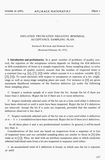Article
Full entry |
 PDF
(1.4 MB)
Feedback
PDF
(1.4 MB)
Feedback
 PDF
(1.4 MB)
Feedback
PDF
(1.4 MB)
Feedback
Summary:
This paper gives the maximum likelihood estimations of the process (or lot) average proportion $p$ of defectives and the proportion $(\alpha)$ of the population which follows a negative binomial distribution based on attribute samples that have been curtailed either with the rejection of a lot on finding the $k$th defective or with the acceptance of it on finding the $K$th nondefective. These estimates are based on inspection from a sequence of $m$ lots of inspected items. Moreover, the linear estimates of $p$ and $\alpha$ and the asymptotic variance and covariance of considered estimators are given.
References:
[1] С. A. Cohen: Curtailed attribute sampling. Technometrics 12 (1970), 295-298. DOI 10.1080/00401706.1970.10488668 | Zbl 0213.20602
[2] H. Cramér: Mathematical methods of statistics. Princeton Univ. Press, Princeton 1946. MR 0016588
[3] C. C. Craig: The ASN for truncated single and double attribute acceptance sampling plans. ASQC Convention Transactions (1968), 63 - 67.
[4] C. C. Craig: The average sample number for truncated single and double attribute sampling plans. Technometrics 10 (1968), 685-692. DOI 10.2307/1267452 | MR 0235669
[5] K. N. Pandey: On generalized inflated Poisson distribution. J. Scient. Res. Banaras Hindu Univ. 15 (1964-1965), 157-162. MR 0202168
[6] G. P. Patil: On the evaluation of the negative binomial distribution with example. Technometrics 2 (1960), 501-505. DOI 10.1080/00401706.1960.10489915 | MR 0119280
[7] G. P. Patil: Note on the equivalence of the binomial and inverse binomial acceptance sampling plans and an acknowledgement. Technometrics 5 (1963), 119-121. DOI 10.1080/00401706.1963.10490062
[8] A. G. Phatak M. M. Bhatt: Estimation of fraction defective in curtailed sampling plans. Technometrics 9 (1967), 219-228. DOI 10.1080/00401706.1967.10490457 | MR 0216708
[9] M. P. Singh: Inflated binomial distribution. J. Scient. Res. Banaras Hindu Univ. 16 (1965 to 1966), 87-90.
[10] S. N. Singh: Probability models for the variation in the number of births per couple. J. Am. Statist. Ass. 58 (1972), 721-727. MR 0152092

